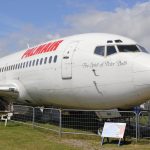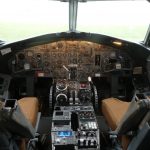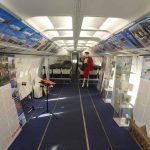Technical Data
Length: 100ft 2in / 30.53m
Height: 36ft 10in / 11.23m
Wing Span: 93ft / 28.35m
Service Ceiling: 35,000ft / 10,700m
Max Speed: 544mph / 780kmh
Max Weight: 128,100lbs / 58,100kgs
Seating Capacity: 136
Engines: 2 x Pratt & Whitney JT8D
Our Aircraft
Boeing 737-229(A) (cn 21135) G-CEAH was originally is one of fifteen Boeing 737-200 series aircraft ordered by Belgian airline Sabena. It first flew in May 1975 and then delivered to Sabena in June registered as OO-SDG. It entered service on the airline’s routes across Europe, which expanded over time, leading to further 737’s being ordered. Sabena decided to supplement its 200 series aircraft with a mix of 300/400/500 series aircraft which were ordered in 1988. Sabena later switched to a fleet of Airbus A320’s which entered service in the mid 1990’s. The remaining fleet of thirteen 737-200 aircraft were sold to European Aviation of Bournemouth in May 1998. However, along with some of the other aircraft, OO-SDG continued in use with Sabena for a while longer and was finally taken out of service in January 2000. It was eventually delivered to European Aviation in October 2000.
OO-SDG was re-registered as G-CEAH and was overhauled for use by European Aviation Air Charter. Along with their other Boeings, G-CEAH replaced European’s ageing fleet of BAC One-Elevens which no longer met worldwide noise regulations. G-CEAH operated charters around Europe (frequently out of Manchester) for a variety of other airlines including Palmair, Jet2 & BMI Baby.
G-CEAH was one of four 737’s still flying with European Aviation when the company went into administration at the end of November 2008. Along with the majority of their fleet it was stored at Bournemouth, but did not find a new buyer. After slowly deteriorating, it was broken up at the end of March 2013 but the main fuselage section was saved and moved to the Museum in December 2013. It was then restored by the volunteers, repainted in the colours of Palmair and named “The Spirit of Peter Bath” as a tribute to the Chairman of the company. The aircraft now contains an exhibition telling the history of Palmair which for a number of years operated out of Bournemouth and frequently picked up Best Airline Awards.
Type History
The Boeing 737 is a narrow-body aircraft produced by Boeing at its Renton Factory in Seattle. It was originally developed to supplement the B727 on short and thin routes. The initial 737-100 made its first flight in April 1967 and entered service in February 1968 with Lufthansa. The lengthened 737-200 entered service in April 1968. It has now evolved through four generations:
The -100/200 original variants were powered by Pratt & Whitney JT8D low-bypass engines and offered seating for 85 to 130 passengers. Launched in 1980 and introduced in 1984, the 737 Classic -300/400/500 variants were re-engined with CFM56-3 turbofans and offered 110 to 168 seats. Introduced in 1997, the 737 Next Generation (NG) -600/700/800/900 variants have updated CFM56-7s, a larger wing and an upgraded glass cockpit, and seat 108 to 215 passengers. The latest generation, the 737 MAX -7/8/9/10, powered by improved CFM LEAP high bypass turbofans and accommodating 138 to 204 people, entered service in 2017. Boeing Business Jet versions are produced since the 737NG, as well as military models.
As of December 2019, 15,156 Boeing 737s have been ordered and 10,571 delivered. Actual backlog stands at 4,398. Initially, its main competitor was the McDonnell Douglas DC-9, followed by its MD-80/MD-90 derivatives. It remained the highest-selling commercial jetliner until surpassed in total orders by the Airbus A320 family in October 2019. In response to the newly designed Airbus A320neo, Boeing introduced the B737 Max with more fuel efficient CFM engines, airframe and aerodynamic improvements such as the split-tip winglets.
The B737 MAX 8 entered service in May 2017. However, following two fatal crashes with Lion Air (Indonesia) in 2018 and Ethiopian Airlines in 2019, the B737 MAX was grounded worldwide in March 2019. The US Federal Aviation Authority made a number of recommendations which Boeing had to complete before the aircraft could be allowed to fly again. These were mainly to rectify design problems with the aircraft’s MCAS system which was largely responsible for the two crashes and also to improve the training of pilots. The aircraft was then certified for operational use in the US from December 2020 and in the UK and Europe from January 2021. It can now be seen flying regularly from Bournemouth with Ryanair and shortly with TUI.


